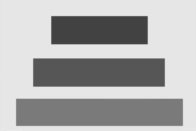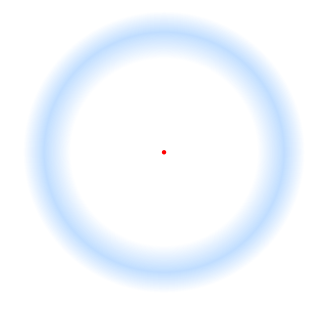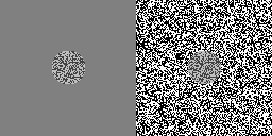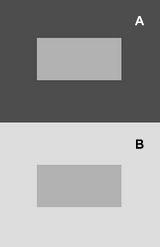
Within visual perception, an optical illusion is an illusion caused by the visual system and characterized by a visual percept that arguably appears to differ from reality. Illusions come in a wide variety; their categorization is difficult because the underlying cause is often not clear but a classification proposed by Richard Gregory is useful as an orientation. According to that, there are three main classes: physical, physiological, and cognitive illusions, and in each class there are four kinds: Ambiguities, distortions, paradoxes, and fictions. A classical example for a physical distortion would be the apparent bending of a stick half immerged in water; an example for a physiological paradox is the motion aftereffect. An example for a physiological fiction is an afterimage. Three typical cognitive distortions are the Ponzo, Poggendorff, and Müller-Lyer illusion. Physical illusions are caused by the physical environment, e.g. by the optical properties of water. Physiological illusions arise in the eye or the visual pathway, e.g. from the effects of excessive stimulation of a specific receptor type. Cognitive visual illusions are the result of unconscious inferences and are perhaps those most widely known.

The Müller-Lyer illusion is an optical illusion consisting of three stylized arrows. When viewers are asked to place a mark on the figure at the midpoint, they tend to place it more towards the "tail" end. The illusion was devised by Franz Carl Müller-Lyer (1857–1916), a German sociologist, in 1889.

The term phi phenomenon is used in a narrow sense for an apparent motion that is observed if two nearby optical stimuli are presented in alternation with a relatively high frequency. In contrast to beta movement, seen at lower frequencies, the stimuli themselves do not appear to move. Instead, a diffuse, amorphous shadowlike something seems to jump in front of the stimuli and occlude them temporarily. This shadow seems to have nearly the color of the background. Max Wertheimer first described this form of apparent movement in his habilitation thesis, published 1912, marking the birth of Gestalt psychology.

A grid illusion is any kind of grid that deceives a person's vision. The two most common types of grid illusions are the Hermann grid illusion and the scintillating grid illusion.

Mach bands is an optical illusion named after the physicist Ernst Mach. It exaggerates the contrast between edges of the slightly differing shades of gray, as soon as they contact one another, by triggering edge-detection in the human visual system.

Depth perception is the visual ability to perceive the world in three dimensions (3D) and the distance of an object. Depth sensation is the corresponding term for non-human animals, since although it is known that they can sense the distance of an object, it is not known whether they perceive it in the same subjective way that humans do.

The Cornsweet illusion, also known as the Craik–O'Brien–Cornsweet illusion or the Craik–Cornsweet illusion, is an optical illusion that was described in detail by Tom Cornsweet in the late 1960s. Kenneth Craik and Vivian O'Brien had made earlier observations in a similar vein.
A contrast effect is the enhancement or diminishment, relative to normal, of perception, cognition or related performance as a result of successive or simultaneous exposure to a stimulus of lesser or greater value in the same dimension.

Ambiguous images or reversible figures are visual forms which create ambiguity by exploiting graphical similarities and other properties of visual system interpretation between two or more distinct image forms. These are famous for inducing the phenomenon of multistable perception. Multistable perception is the occurrence of an image being able to provide multiple, although stable, perceptions.

White's illusion is a brightness illusion where certain stripes of a black and white grating is partially replaced by a gray rectangle. Both of the gray bars of A and B are the same color and opacity. The brightness of the gray pieces appear to shift toward the brightness of the top and bottom bordering stripes. This is in apparent opposition to lateral inhibition as it cannot explain this occurrence. This occurs even when the gray patches in the black stripes are bordered by more white than black. A similar illusion occurs when the horizontal strips have different colors; this is known as Munker–White's illusion, Munker's illusion, or Bezold effect.

The Hering illusion is one of the geometrical-optical illusions and was discovered by the German physiologist Ewald Hering in 1861. When two straight and parallel lines are presented in front of radial background, the lines appear as if they were bowed outwards. The Orbison illusion is one of its variants, while the Wundt illusion produces a similar, but inverted effect.

Illusory contours or subjective contours are visual illusions that evoke the perception of an edge without a luminance or color change across that edge. Illusory brightness and depth ordering often accompany illusory contours. Friedrich Schumann is often credited with the discovery of illusory contours around the beginning of the 20th century, but they are present in art dating to the Middle Ages. Gaetano Kanizsa’s 1976 Scientific American paper marked the resurgence of interest in illusory contours for vision scientists.

In vision, filling-in phenomena are those responsible for the completion of missing information across the physiological blind spot, and across natural and artificial scotomata. There is also evidence for similar mechanisms of completion in normal visual analysis. Classical demonstrations of perceptual filling-in involve filling in at the blind spot in monocular vision, and images stabilized on the retina either by means of special lenses, or under certain conditions of steady fixation. For example, naturally in monocular vision at the physiological blind spot, the percept is not a hole in the visual field, but the content is “filled-in” based on information from the surrounding visual field. When a textured stimulus is presented centered on but extending beyond the region of the blind spot, a continuous texture is perceived. This partially inferred percept is paradoxically considered more reliable than a percept based on external input..

Motion Induced Blindness (MIB) is a phenomenon of visual disappearance or perceptual illusions observed in the lab, in which stationary visual stimuli disappear as if erased in front of an observer's eyes when masked with a moving background. Most recent research has shown that microsaccades counteract disappearance but are neither necessary nor sufficient to account for MIB.

The watercolor illusion, also referred to as the water-color effect, is an optical illusion in which a white area takes on a pale tint of a thin, bright, intensely colored polygon surrounding it if the coloured polygon is itself surrounded by a thin, darker border. The inner and outer borders of watercolor illusion objects often are of complementary colours. The watercolor illusion is best when the inner and outer contours have chromaticities in opposite directions in color space. The most common complementary pair is orange and purple. The watercolor illusion is dependent on the combination of luminance and color contrast of the contour lines in order to have the color spreading effect occur.

Neon color spreading is an optical illusion in the category of transparency effects, characterized by fluid borders between the edges of a colored object and the background in the presence of black lines. The illusion was first documented in 1971 and was eventually rediscovered in 1975 by Van Tuijl.

A phantom contour is a type of illusory contour. Most illusory contours are seen in still images, such as the Kanizsa triangle and the Ehrenstein illusion. A phantom contour, however, is perceived in the presence of moving or flickering images with contrast reversal. The rapid, continuous alternation between opposing, but correlated, adjacent images creates the perception of a contour that is not physically present in the still images. Quaid et al. have also authored a PhD thesis on the phantom contour illusion and its spatiotemporal limits which maps out limits and proposes mechanisms for its perception centering around magnocellularly driven visual area MT.

Due to the effect of a spatial context or temporal context, the perceived orientation of a test line or grating pattern can appear tilted away from its physical orientation. The tilt illusion (TI) is the phenomenon that the perceived orientation of a test line or grating is altered by the presence of surrounding lines or grating with a different orientation. And the tilt aftereffect (TAE) is the phenomenon that the perceived orientation is changed after prolonged inspection of another oriented line or grating.

Visual processing abnormalities in schizophrenia are commonly found, and contribute to poor social function.

Beau Lotto is a Professor of Neuroscience and author. He is a professor at University of London, as well as a visiting scholar at New York University. His research explores how the brain adapts to uncertainty at the cellular, computational and perceptual levels with the aim of understanding the fundamental principles of biologically-inspired innovation.





















